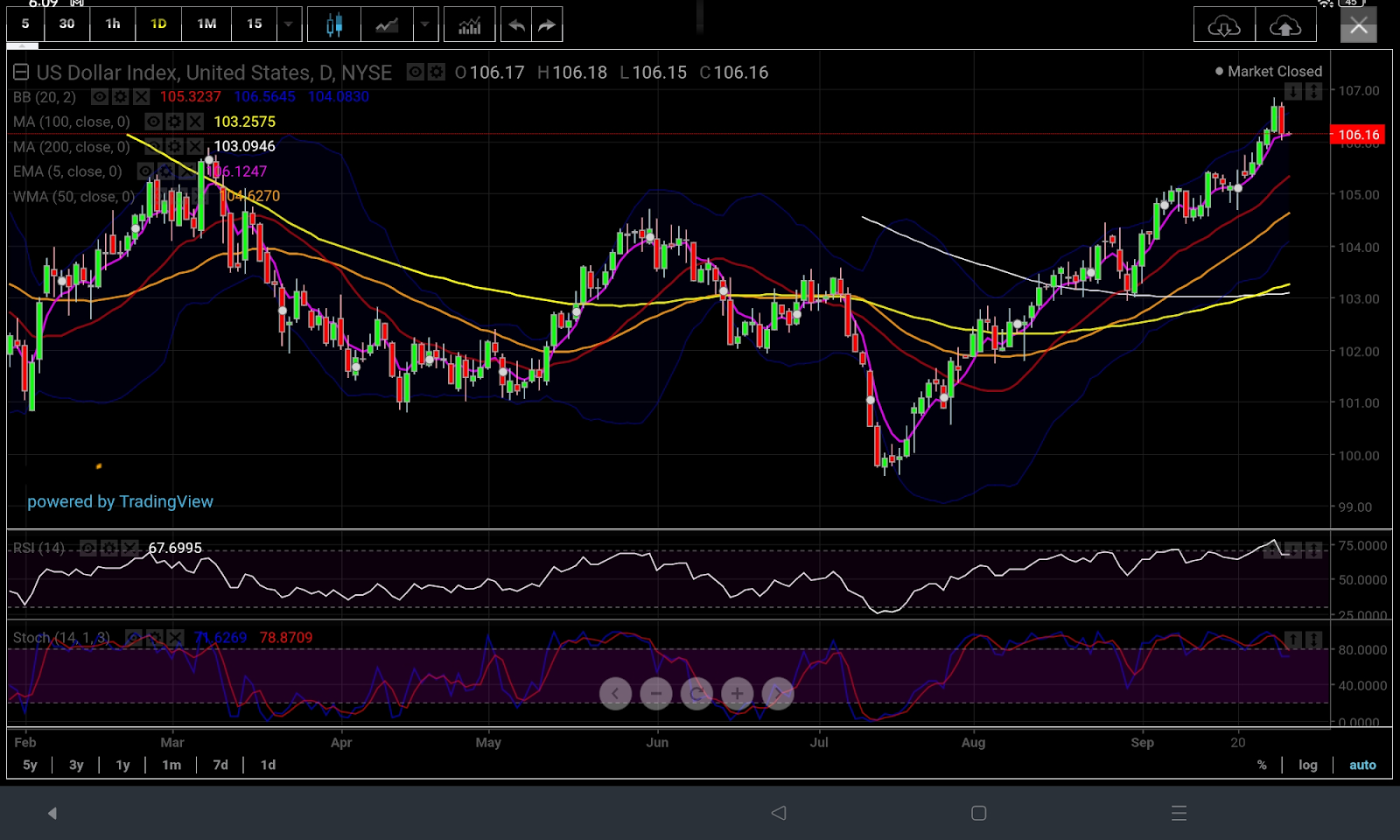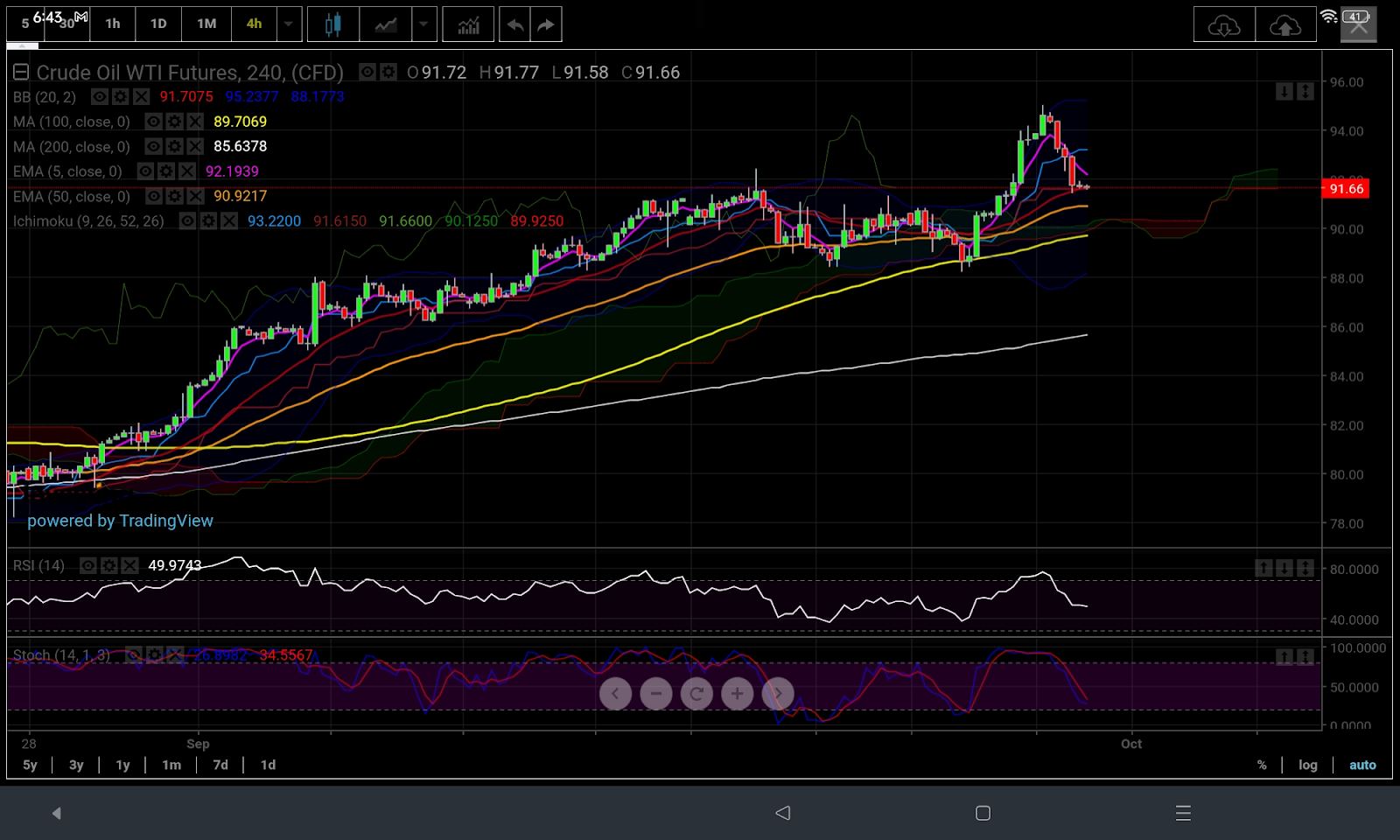- Greenback to take a breather after 8-weeks long rally; direction remains bullish
- Similarly, oil could retest $90
- Fed actions, bond market shifts, and speculative positions to tell the market direction going forward
They are two of the world’s biggest trades and both are overcrowded on the long side, with charts suggesting the need for meaningful corrections.
But the question really is: Will we get more than just piddly moves down in the and that won’t get erased in the next session?
The Dollar as It Stands

Charts by SKCharting.com, with data powered by Investing.com
At the time of writing, the Dollar Index Futures — which is reflective of the US currency’s performance in pairings like the euro-led , the yen-themed and Aussie-driven — hovered at 106. That was a combined drop of 0.6% over two sessions after Wednesday’s run to a 10-month high of 106.84.
But instead of pushing down further for a test of 105 — a level that will effectively neutralize three weeks of the greenback’s eight-week long rally, giving it the energy to regroup and run even higher — chart studies by Investing.com indicate DXY may jack-knife the other way soon.
Sunil Kumar Dixit, chief technical strategist at SKCharting.com, who collaborated with us on the study, says the index could instead spring for a shot at 107, adding:
“The current pullback of the DXY may be just a breather for the dollar, rather than actual weakness.”
Dixit observed that DXY did shed some gains from Wednesday’s highs to drop to 106.02 and close Thursday’s session at 106.17, marginally above the 5-Day EMA, or Exponential Moving Average, of 106.13.
“Further decline is likely on a sustainable breakdown that should target the 38.2% Fibonacci zone of 105.39 in the wake of momentum distribution.
However, consolidation above 106.26 may provide Dollar Index potential for reclaiming its 106.84 heights, above which the 50% Fibonacci zone of 107.18 sits as a strategic resistance.”
DXY’s charts suggest the 107 level could be the first real hard wall for the dollar in a while.
But Dixit also notes that there could be volatile swings as the uptrend had left the rally substantially vertical and open for heightened fluctuations.
“The 50% Fibonacci level is the first and important gateway to resumption of yet another bull run in DXY as this zone is strongly established by consistency in price action.
This zone is often seen to act as a coordinate which has potential to either strengthen the continuation of trend or flip the trend altogether.”
What’s Driving the Dollar?
All three of the most liquid dollar pairings — EUR/USD, USD/JPY, and AUD/USD — have been moving to the greenback’s advantage.
The primary reason for this is the super-hawkishness of the Federal Reserve versus other global central banks and the relative outperformance of the US economy compared with that of Europe, Japan, and Australia.
The Fed had raised interest rates 11 times between March 2022 and July 2023, adding a total of 5.25 percentage points to a prior peak rate of just 0.25%.
While the Fed left rates unchanged at its , it maintained projections that it could have a quarter-point hike before the year ended, in either November or December.
It also indicated that rate hikes could continue into 2024 if warranted by inflation, which was at 3.7% per annum versus the targeted 2%.
Fed Chair Powell said energy-driven inflation was one of the central bank’s bigger concerns, with oil prices having risen around 30% in just three months. US bonds have, meanwhile, sold off nonstop for five months now, with the yield on the benchmark 10-year Treasury hitting 16-year highs, accelerating the dollar’s charge.
“We are prepared to raise rates further, if appropriate,” Powell told a news conference after the centraank’s Sept. 20 meeting. “The fact that we decided to maintain the policy rate at this meeting doesn’t mean we have decided that we have or have not at this time reached that stance of monetary policy that we are seeking.”
The US economy, meanwhile, grew at a decent 2.1% in the second quarter, just a shade beneath the 2.2% in the first. It is projected to expand by 1.5% in 2024 and by 2.4% in 2025.
The ECB, in contrast, raised rates by a quarter point at its September meeting but also signaled that would be the last hike in the current tightening regime, reinforcing the notion that Europe’s monetary authorities were ready to settle into a lower-for-longer rate regime hereon. The euro area economy is projected to grow by just 0.7% in 2023, by 1.0% in 2024, and by 1.5% in 2025.
The euro has gained ground against the dollar in the past two sessions, with EUR/USD reaching 1.0586 at the time of writing. That is still less than 1% higher from Wednesday’s 8-month low of 1.0488.
“The euro’s recovery beyond 1.06 might stall as 1.0610 and 1.0660 are areas of challenge,” said Dixit.
The yen has also been on a weak footing as the Bank of Japan maintains an ultra-loose monetary policy. The Japanese economy is projected to grow 0.5% percent in 2024 and 0.4% percent in 2025.
“USD/JPY has been speeding towards 150, above which the October 2022 high of 151.90 will come. After that, it could be 153.90. A credible turning point and support will be 148.50.”
The Reserve Bank of Australia similarly did not any rate changes or tightening in policy in September. Economists say the RBA will likely pause on rates for about a year as Australia tries to bolster its weakened economy.
What Could Change For The Dollar?
- The dollar’s appreciation may start to slow if US economic data underperforms to expectations (the contrary is happening now); the Fed announces an end to its regime of higher-for-longer rates or other central banks begin tightening rates.
- The risk of a US recession if the bond market selloff continues, could also halt the dollar’s advance.
- A partial US government shutdown by this weekend could put a damper on the dollar’s run higher, pushing it down towards 105.39.
Oil as It Stands

US crude’s benchmark, the West Texas Intermediate, or as it’s known in short, hovered under $91.65 per barrel at the time of writing.
WTI settled at $91.71 in the previous session, down $1.97, or 2.1%, for its sharpest one-day selloff in nearly two months. Prior to that, it reached $95.04, its highest since August 2022. On Wednesday alone the US crude benchmark jumped 3.7%.
Said Dixit:
“As WTI’s bullish momentum takes a break from $95, which is $1 short of $96 resistance, overbought conditions forced rebalancing, causing pull back to the 5-day EMA of $91.40.
This calibration is likely to extend WTI’s decline to the Daily Middle Bollinger Band of $89.50, followed by the horizontal support zone at $88.20.”
Those levels suggest that WTI has another 3% or more to lose. But like the dollar, the crowded long-oil trade might get more unwieldy instead. Dixit’s counter scenario for WTI:
“Consolidation above the 5-day EMA, dynamically positioned at $91.50, can contribute to a resumption of the bullish trend aiming again for the $96 resistance.”
What’s Driving Oil?

WTI has gained more than $25 from May lows beneath $64 for WTI. The rally was largely in response to production squeezes by Saudi Arabia and Russia in their bid to “balance” the market — or rather create an imbalance so great between short supplies and stagnant demand that prices would have no choice but to rise.
The two prime movers of the OPEC+ alliance — which bands the 13-member Saudi-led Organization of the Petroleum Exporting Countries with 10 independent oil producers steered by Russia — have also benefited from a tacit collusion by US oil producers.
While antitrust laws forbid US energy companies from participating in OPEC-like schemes that are against the spirit of free-market competition, American oil firms, lured by the Saudi bent in getting a barrel back to above $100, have restrained production too whenever possible in the name of returning cash to shareholders.
Demand for US crude has, however, exploded internationally as it began to fill some international markets underserved by the Saudi-Russian squeeze. That has led to a plunge in inventory levels at the Cushing, Oklahoma hub that serves as a central delivery and storage point for US crude. This is especially so with the pick-up in shipments of a new US crude grade called WTI Midland — which is comparable to the viscosity of the heavier Arab and Russian oils versus the typically light-grade that’s WTI.
Profits on refined products have also fueled the rally, with a focus particularly on the “crack spread” for which measures the difference between the purchase price of a barrel of crude and that of heating oil. The heating-oil crack spread traded to a nine-month high of $58.17 a barrel on Aug. 25 and remained “supersized” above $50 a barrel through mid-September, before declining to to a two-month low of $40.595 on Wednesday, Bob Yawger, energy analyst at Mizuho said in comments carried by MarketWatch.
Speculators have also continued to rush into crude, with so-called commitments of traders data from the government showing net long speculative contracts at 294,396 as of the week ending Sept. 19, Yawger observed. He expects that figure to rise further when the next update is released for the week ending Sept. 26.
What Could Change For Oil?
- The risk of downside for oil is very much real if the selloff in bonds — a precursor to recession — continues.
- Crude demand destruction will clearly happen globally if the bond market selloff extends, says Ed Moya, analyst at online trading platform OANDA. He put major support for WTI at $84.
- Extreme speculative positions in WTI could also make for a sharp reversal in direction if oil longs are forced to liquidate. Reuters’ market analyst John Kemp says oil traders have placed so many bullish bets on crude prices that the trade has become overcrowded and was due for a correction.
- In his latest column on oil buying among institutional traders, Kemp pointed out that over the past four weeks, traders had bought a total of 183 million barrels of crude and fuel futures. That has brought the total up to 525 million barrels. More importantly, the ratio of bullish to bearish bets on oil and fuels had risen to almost 8:1. According to Kemp, this is a sign that oil prices may start reversing their gains before too long.
- Wall Street getting it wrong — JP Morgan said this week that , the global benchmark for oil, could reach $150 per barrel. Other commodity analysts see Brent hitting $100 before this year’s end. But forecasters at investment banks are often too caught up in chasing a market one way that they ignore counteracting forces. And one of the bigger risks to the oil rally remains the Fed and its higher-for-long regime for US interest rates and its impact on the economy, ultimately.
***
Disclaimer: The aim of this article is purely to inform and does not in any way represent an inducement or recommendation to buy or sell any commodity or its related securities. The author Barani Krishnan does not hold a position in the commodities and securities he writes about. He typically uses a range of views outside his own to bring diversity to his analysis of any market. For neutrality, he sometimes presents contrarian views and market variables.

